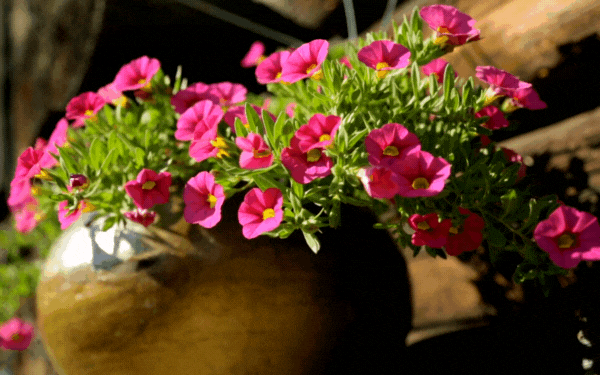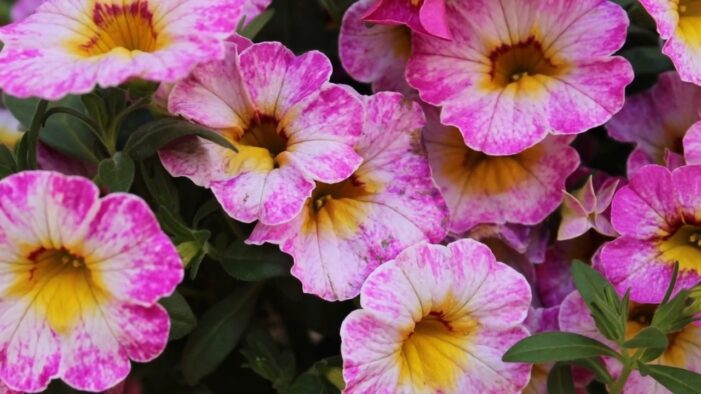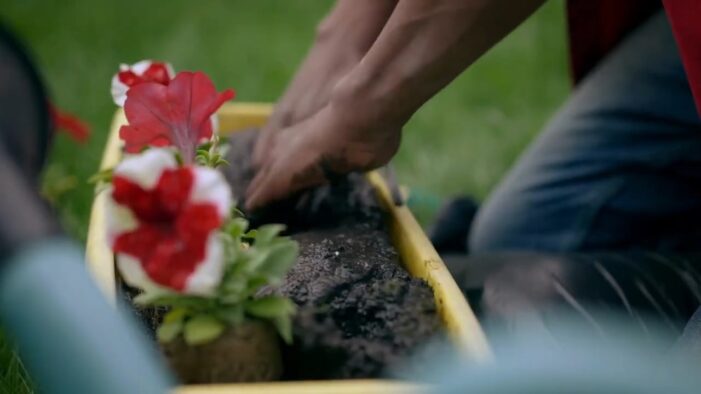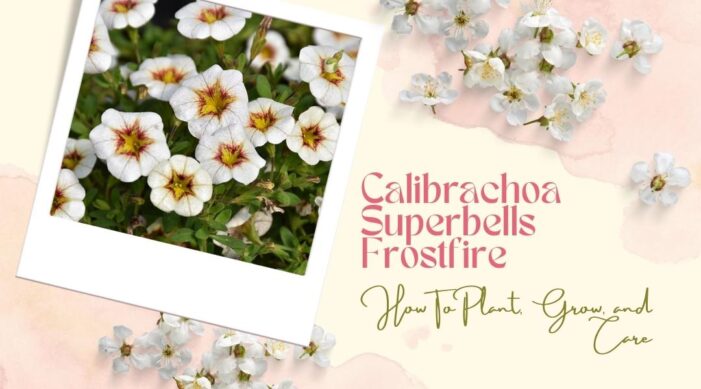Calibrachoa, specifically the Superbells Frostfire variety, has captured the hearts of many gardeners with its captivating beauty and easygoing nature.
In this article, we’ll be sharing essential tips and tricks to help you successfully plant, grow, and care for this enchanting flowering plant. So grab your gardening gloves and let’s get started!
| Attribute | Description |
|---|---|
| Common Name | Calibrachoa, million bells, trailing petunia, mini petunia |
| Botanical Name | Calibrachoa group |
| Family | Solanaceae |
| Plant Type | Herbaceous perennial flower grew as an annual |
| Mature Size | 6–12 in. tall, 12–24 in. wide |
| Sun Exposure | Full sun to part shade |
| Soil Type | Moist, rich, well-drained |
| Soil pH | 5.0–6.5 (acidic) |
| Bloom Time | Spring to fall |
| Flower Color | Coral, yellow, orange, red, pink, blue, purple, burgundy, lavender, cream |
| Hardiness Zones | 9–11 (USDA); grown as an annual in all zones |
| Native Area | South America |
Calibrachoa Care
Even though Calibrachoa is a short-lived perennial in particularly warm climates, it’s predominantly grown as an annual across various regions.
This plant isn’t difficult to care for, but catering to its needs will ensure that it continues to bloom from spring until fall. While it can be planted in garden beds, Calibrachoa truly thrives in containers.
Known as a “self-cleaning” plant, Calibrachoa doesn’t require deadheading to maintain its blooms.
However, it will benefit from a substantial trimming towards the end of summer, along with a dose of fertilizer to reinvigorate it.
Although not classified as deer-resistant, deer don’t seem to be overly interested in this plant.
Light
For optimal blooming, Calibrachoa requires a minimum of six hours of full sun daily.
However, it can also tolerate partial shade, particularly in warmer regions where plants with some shade have a better chance of surviving through the summer months. Insufficient sunlight typically leads to reduced blooming.
Soil
This plant thrives in well-draining potting soil, so ensure your container has proper drainage.
When planting in garden beds, enrich the soil with organic material and confirm that it drains well. Using mulch is recommended to maintain soil moisture and keep the root system cool.
Water

Keep Calibrachoa well-hydrated without waterlogging it. Water the plant only when the top inch or so of the soil has dried out. To determine if your plant needs water, insert your finger into the soil up to the second knuckle. If the soil feels dry, water it deeply until it drains out of the bottom of your pot, and refrain from watering again until the soil dries.
Factors like heat, wind, and low humidity can cause the soil to dry out rapidly. Depending on your conditions, you may need to water your plant up to twice a day.
Regularly check the soil, especially at the beginning of the season, to familiarize yourself with your plant’s needs, as watering requirements may change when summer temperatures rise. Avoid overwatering to prevent root rot.
Temperature and Humidity
Calibrachoa is reasonably drought-, heat-, and cold-tolerant. However, to achieve the best blooms, prevent the plant from drying out repeatedly.
It prefers temperatures between 55 and 65 degrees Fahrenheit. Once hardened off, Calibrachoa can be moved outdoors during spring and can withstand mild frosts.
Conversely, hot weather and dryness can stress the plant. Revive wilted foliage with daily misting, but avoid misting in direct sunlight as this can scorch the leaves.
Fertilizer
As a heavy feeder, Calibrachoa benefits from slow-release fertilizers at planting and/or regular diluted liquid fertilizers.
For instance, you can begin with an organic, slow-release fertilizer mixed into your potting medium and then feed the plant a diluted liquid solution every couple of weeks throughout the season.
Feeding is especially important towards the end of the season to encourage late blooms.
Be cautious not to over-fertilize and follow the plant food label’s directions closely. Light green or yellowish leaves may indicate that the plant needs fertilizer or possibly more sunlight.
Types
The Calibrachoa genus consists of 28 different species, but garden cultivation primarily involves complex hybrids derived from crossing various species. There are numerous Calibrachoa varieties available in an extensive range of colors, including:
- Calibrachoa ‘Cabaret Hot Pink’: Features bright pink flowers on trailing stems up to 8 inches long.
- C. ‘Cabaret Purple Glow’: Grows 12 inches wide with trailing stems up to 8 inches.
- C. ‘Million Bells® Terra Cotta’: Boasts orange flowers streaked with red and gold on stems trailing to 8 inches.
- C. ‘MiniFamous Double Blue’: Has deep blue-purple double flowers on a trailing plant with 10-inch-long stems.
- C. ‘Superbells® Pomegranate Punch’: Displays velvety-red flowers that darken towards the center, growing 8 inches tall.
- C. ‘Kabloom’: A series of hybrid plants that can be grown from seed, available in pink, white, red, yellow, and deep blue.
Propagating Calibrachoa

Garden-grown Calibrachoa plants are hybrids that produce few seeds. Since many varieties are trademarked hybrids, vegetative propagation through cuttings is technically illegal. However, if you attempt to propagate through cuttings, follow these steps:
- Look for a stem with small buds but no flowers. Using a clean, sharp cutting tool, cut off the stem at least 6 inches from the tip and remove any lower leaves.
- Place the cuttings in a 50-50 mix of potting soil and peat moss, then water thoroughly.
- Keep the cuttings under bright light, maintaining a moist and warm environment (around 70 degrees Fahrenheit). Roots should begin to develop within a couple of weeks.
Potting and Repotting
When purchasing million bells plants, they are often severely root-bound, leaving little soil in the pot. As a result, there’s a slim margin of error for watering and minimal nutrition available for the plants. When repotting the plant from its original container, loosen the root ball and add a slow-release fertilizer to a general-purpose potting mix. These short-lived plants won’t require further repotting. Any container material can house these spiller plants, but ensure there are ample drainage holes.
Common Pests
Calibrachoa plants are highly susceptible to aphids. To remove aphids, spray the plant with water, a water and dish detergent mix, or neem oil.
Common Problems with Million Bells

Aphids aside, the most frequent issue encountered with Calibrachoa plants is yellowing leaves. Yellowing leaves may result from:
- Iron deficiency (new growth yellows)
- Nitrogen deficiency (old growth yellows)
- Root rot
Landscape: Tips and Tricks
Calibrachoa, a highly versatile annual, can easily brighten up any outdoor space. Here are some creative ideas to weave this delightful plant into your landscape:
- Welcome with color: Position a couple of tall ceramic pots near your home’s entrance and fill them with vibrant Superbells® to create a warm and inviting atmosphere for your guests.
- Add charm to structures: Enhance the beauty of arbors and pergolas by hanging baskets overflowing with your favorite Calibrachoa colors, creating an eye-catching focal point.
- Complement your home: Plant window boxes in areas that receive at least six hours of sunlight, selecting Calibrachoa hues that accentuate your home’s exterior and tie everything together.
- Embrace flexibility: Shepherd’s hooks are an excellent way to showcase hanging baskets filled with Calibrachoa, providing instant color around patios, decks, or poolside areas. The hooks can be easily moved and rearranged for a refreshed look whenever you desire.
- Bring nature to your window: Hang a basket filled with Calibrachoa outside your kitchen window, offering a burst of color as you cook or wash dishes. This display will also attract hummingbirds and butterflies, allowing you to enjoy their beauty up close.
By integrating Calibrachoa into your landscape using these tips, you’ll create an enchanting and dynamic outdoor space for all to admire. Enjoy experimenting with the various colors and arrangements of this delightful plant!
FAQs

Are million bells easy to care for?
Absolutely! Million bells, also known as Calibrachoa, are a delightfully easy-to-care-for plant.
They’re well-suited for those who want to add vibrant colors to their outdoor spaces without investing a significant amount of time and effort in maintenance.
These charming plants are low-maintenance and bloom continuously throughout the growing season, bringing a cheerful display to your garden or patio.
How fast do million bells grow?
They are known for their relatively fast growth rate, which is one of the reasons they’re so popular among gardeners. When provided with the proper care, these delightful plants can quickly fill up hanging baskets or containers, creating a stunning cascade of vibrant blooms.
Within a few weeks of planting, you can expect to see noticeable growth in both the foliage and blossoms. Throughout the growing season, which typically spans from spring to the first frost, a million bells will continue to grow and produce their charming, petunia-like flowers.
What’s the difference between a million bells and petunias?
Though a million bells (Calibrachoa) and petunias may appear quite similar at first glance, they are indeed different plants with distinct characteristics. Both belong to the Solanaceae family, which explains their resemblance, but there are a few key differences between them:
- Flower size: Million bells produce smaller, 1-inch flowers that resemble mini petunias. Petunias, on the other hand, have larger flowers that can measure up to 4 inches across.
- Growth habit: Million bells are known for their trailing habit, making them an excellent choice for hanging baskets or containers where they can cascade over the edges. Petunias are available in a wider range of growth habits, from compact and mounding to trailing and spreading varieties.
- Maintenance: Million bells are considered “self-cleaning,” meaning they don’t require deadheading to continue blooming. Petunias, however, often benefit from regular deadheading to encourage more blooms and maintain a tidy appearance.
- Bloom duration: Million bells are prolific bloomers that flower continuously from spring until the first frost. Petunias, while still providing an impressive floral display, may have a slightly shorter blooming period and can become leggy as the season progresses.
- Disease resistance: Calibrachoa plants tend to be more resistant to certain diseases, such as tobacco budworm, that can affect petunias.
Despite these differences, both million bells and petunias are excellent choices for adding vibrant colors to your garden, containers, or hanging baskets.
Conclusion
This is a delightful and easy-to-grow plant that offers vibrant colors and a continuous bloom throughout the growing season.
With its low-maintenance nature and charming, petunia-like flowers, it’s no wonder that these plants have become a favorite among gardeners.
By following the tips and tricks shared in this article, you’ll be well on your way to creating a captivating and enchanting outdoor space featuring this beautiful flowering plant.
So, roll up your sleeves, gather your gardening gear, and prepare to be dazzled by the charming world of Calibrachoa!
Happy gardening!

